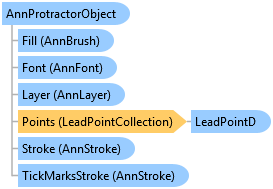| Leadtools.Annotations.Core Namespace : AnnProtractorObject Class |

public class AnnProtractorObject : AnnPolyRulerObject, IAnnObjectCloneable
Public Class AnnProtractorObject Inherits AnnPolyRulerObject Implements IAnnObjectCloneable
public sealed class AnnProtractorObject : IAnnObjectCloneable
@interface LTAnnProtractorObject : LTAnnPolyRulerObject<NSCoding,NSCopying>
public class AnnProtractorObject extends AnnPolyRulerObject
function Leadtools.Annotations.Core.AnnProtractorObject()
The protractor annotation object consists of two rulers joined at a point to create an angle. The center point is CenterPoint, the first line ends at FirstPoint and the second point ends at SecondPoint.
With the automated functions, the first line of the protractor is started on a click or tap event and completed on a second click or tap event. The second line is completed on a third click or tap event.
With the automated functions, on systems with touch support, the first line segment starts with the first tap and hold. Each successive tap and hold for 1.5 seconds results in a new line segment. The object is completed by the user removing the finger from the device.
Programmatically, the boundaries and location of the protractor object can be controlled using the following properties:
Each object can be transformed with the following methods:
The AnnProtractorObject class inherits a number of properties from the AnnObject class, providing support for font, stroke and fill characteristics. These properties are listed below:
The name of the protractor object can be controlled using Labels property, inherited from the AnnObject class.
An object can be part of a group annotation object or part of a container object. It cannot be part of both a group and a container at the same time.
Since the annotation protractor object consists of two rulers, it has certain ruler characteristics pertaining to the length, tick marks and gauge. The following properties may be used to customize these ruler characteristics and determine what exactly is displayed when the cross-product object is drawn:
The following properties can also be used to programmatically set characteristics of an AnnProtractorObject:
 Copy Code
Copy Code
using Leadtools.Annotations.Automation; using Leadtools.Annotations.Core; using Leadtools.Codecs; using Leadtools.WinForms; public void AnnCore_AnnProtractorObject() { // assumes _automation is valid double inch = 720.0; // Add a protractor object AnnProtractorObject protractorObj = new AnnProtractorObject(); // Set the points for the protractor protractorObj.FirstPoint = LeadPointD.Create(5 * inch, 1 * inch); protractorObj.CenterPoint = LeadPointD.Create(1 * inch, 3 * inch); protractorObj.SecondPoint = LeadPointD.Create(5 * inch, 5 * inch); // Set the radius protractorObj.ArcRadius = LeadLengthD.Create(350); // Add the object to the automation container _automation.Container.Children.Add(protractorObj); // Select the object _automation.SelectObject(protractorObj); }
using Leadtools.Converters; using Leadtools.Annotations.Automation; using Leadtools.Controls; using Leadtools.Annotations.Core; using Leadtools.Codecs; [TestMethod] public void AnnCore_AnnProtractorObject() { // assumes _automation is valid double inch = 720.0; // Add a protractor object AnnProtractorObject protractorObj = new AnnProtractorObject(); // Set the points for the protractor protractorObj.FirstPoint = LeadPointDHelper.Create(5 * inch, 1 * inch); protractorObj.CenterPoint = LeadPointDHelper.Create(1 * inch, 3 * inch); protractorObj.SecondPoint = LeadPointDHelper.Create(5 * inch, 5 * inch); // Set the radius protractorObj.ArcRadius = LeadLengthDHelper.Create(350); // Add the object to the automation container _automation.Container.Children.Add(protractorObj); // Select the object _automation.SelectObject(protractorObj); }